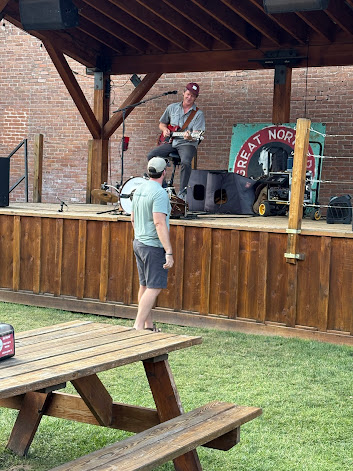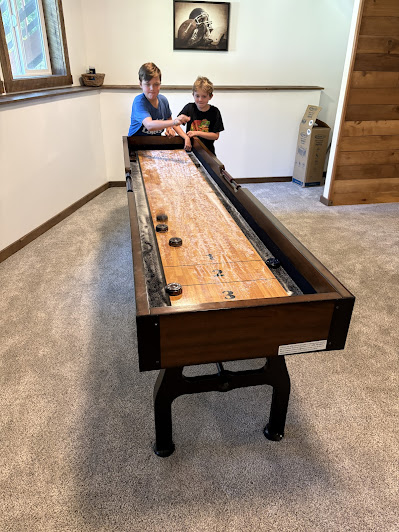The next day after seeing Glacier National Park we left Columbia Falls, Montana and drove to Great Falls, Montana with a stop along the way at a lake for lunch at Lake Frances
Once we got to Great Falls, we checked in to our place, made dinner and still had time before the rodeo to also go to the carnival at the State Fair.
I grew up seeing a rodeo every year in Santa Fe, New Mexico, but I think this was the first one for Kelly, Jon and the boys.
Pam and I opted to go see the animals while the boys checked out a few rides. The rodeo didn’t start until 7 PM.Then we came upon a chance to milk a goat. Have you ever milked a goat? Me either. We both took a shot at it.
World‑Ranked Competitors at Big Sky Rodeo
Saddle Bronc Riding
Zeke Thurston — World top‑10 (multiple PRCA World Champion); recorded an 86‑point ride on Tuca’s Warsongin the Great Falls saddle bronc rounds
Sage Newman — Also among top‑ranked bronc riders; scored 87 in a Big Sky round and was listed among event leaders
Tie‑Down Roping
Zack Jongbloed — Secured first-round win (8.3 sec), second in average at Big Sky; ranked in world top‑10 prior
Haven Meged — Placed top‑3 in first-round Big Sky (8.9 sec), and held top‑10 world standing before the rodeo
Steer Wrestling
Ty Erickson — Former World Champion and long-time top in steer wrestling; competed at Big Sky (he holds Montana roots) d appears in featured repo
This was the first ever rodeo for Jon (and maybe Kelly) and the boys and we were treated with some great scenes:
Event Highlights:
Bareback Riding:
Tanner Ross wowed the crowd with an 87-point ride on Bar T Rodeo’s “Whiskey River,” securing the win and adding to his season total in the PRCA world standings.Saddle Bronc Riding:
Defending champion Jake Finlay delivered a near-flawless 89-point ride, edging out the competition and earning top honors for the night.Bull Riding:
The crowd erupted as Boudreaux Campbell covered “Midnight Fire” for 91.5 points—the highest score of the weekend—securing both the round win and a big payout.Steer Wrestling:
In one of the tightest races, Ty Erickson posted a time of 3.8 seconds, taking the win and continuing his hot summer run.Tie-Down Roping:
With sharp timing and precision, Shad Mayfield stopped the clock at 7.9 seconds, clinching first place and thrilling rodeo fans.Team Roping:
The duo of Clay Smith (header) and Jake Long (heeler) put together a lightning-fast 4.2-second run to claim the top spot on the leaderboard.
Barrel Racing:
Montana favorite Shelley Morgan tore up the pattern in 16.93 seconds, earning a loud ovation and the event buckle.
More photos:
We weren’t sure whether or not there was going to be an event called “Mutton Busting”.
In mutton busting, a child is placed on the back of a sheep and tries to hold on as the animal runs across a short arena. Similar in concept to bull or bronc riding, the goal is to stay on as long as possible—usually just a few seconds—while the sheep bucks or bolts in surprise.
Children wear helmets and sometimes protective vests.
The event is non-competitive in some places, meant purely for fun.
In more structured rodeos, riders may be scored or timed.
History of Mutton Busting
Origins: The exact origins are unclear, but the event likely began in Western U.S. rodeos in the 1960s or 70s, as a safer way for kids to get involved in the rodeo tradition.
Growth: It has grown in popularity across North America and is now a staple at many local and pro-level rodeos, including PRCA events.
Purpose: It serves as both crowd entertainment and a cultural nod to the cowboy lifestyle—often described as a child’s "first ride."
Atmosphere & Entertainment:
The energy was electric, with live music following the rodeo, food vendors, and a patriotic grand entry to kick off the night. Fans were treated to both elite competition and family-friendly entertainment, including clown acts and junior rodeo showcases.
We thoroughly enjoyed the evening and our time in Great Falls. Next stop for a few...Bozeman Montana and the Reunion Phase of our trip.
As always, thanks for joining us on the Roadrunner Chronicles!





























































